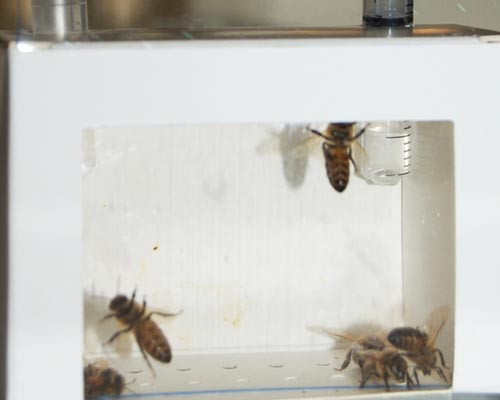OECD TG 213: Honeybees, Acute Oral Toxicity test
Agriculture provides habitat and forage for pollinating insects such as honey bees.
As well as producing honey and a variety of hive products, honey bees perform the ecosystem service of pollination which allows plants to reproduce, provides the fruits, seeds and foliage.The use of plant protection product in agriculture leads to exposure of honey bees to pesticide residues. The oral exposure comes mainly from pollen and nectar consumption from the treated crops, from the weeds in treated field, from plants in field margins and from the adjacent crops where the liquid or solid particles resulting from spray/dust drift might be present.
A minor route of exposure to take into account derived from water consumption in terms of guttation fluids, surface waters and ponds.
Adult worker honeybees are exposed to the test substance dispersed in the diet (sucrose solution) in order to evaluate the mortality and sublethal effects. Mortality and sublethal effects are assessed at 4, 24 and 48 hours after the administration of contaminated diet. If an extention is needed, further observations are carried out at 72 and 96 hours after the beginning of the test.
TEST SYSTEM
Adult honey bees of Apis mellifera L.

STUDY DESIGN
Range finding test includes at least 3 doses of the test substance and 1 untreated control, at least 2 replicates for treatment and for the control with 10 bees/replicate.
Limit test is carried out with 1 dose of the test substance, 1 toxic reference substance and 1 untreated control, 5 replicates for treatment and for the control with 10 bees/replicate.
Dose-response test includes at least 5 doses of the test substance, 1 toxic reference substance and 1 untreated control, 3 replicates for treatment and for the control with 10 bees/replicate.
ENDPOINTS
Mortality: LDx/NOED and behavioural abnormalities are recorded.
Study includes GLP management and reporting.
REFERENCES AND GUIDELINES
OECD Guideline fo Testing of Chemicals, No. 213 (21st September 1998) – Honeybees, Acute oral toxicity test.
Study finder
Scientific Contact
Sabrina Mantilacci
E-mail: mantilacci@biotecnologiebt.it
Phone: +39 075 895 0045 – Ext. 268
Business Contact
Katy Lazzari
E-mail: klazzari@biotecnologiebt.it
Phone: +39 075 895 0045 – Ext. 246
Need more info? Send us a message
Fill in the form with the required information (*).
Our team will be happy to provide all the necessary support with regard to your request.


 English
English Italian
Italian